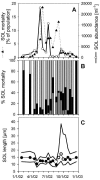Recurrent seasonal variations in abundance and composition of filamentous SOL cluster bacteria (Saprospiraceae, Bacteroidetes) in oligomesotrophic Lake Mondsee (Austria)
- PMID: 16820462
- PMCID: PMC1489297
- DOI: 10.1128/AEM.02935-05
Recurrent seasonal variations in abundance and composition of filamentous SOL cluster bacteria (Saprospiraceae, Bacteroidetes) in oligomesotrophic Lake Mondsee (Austria)
Abstract
The spatial and temporal variation of SOL cluster bacteria was assessed in oligomesotrophic Lake Mondsee and adjacent lakes by fluorescence in situ hybridization over two annual cycles. The filamentous SOL bacteria were present in Lake Mondsee throughout the study period, and the seasonal dynamics of the SOL community were remarkably similar with respect to both abundance and composition in the two consecutive years. Only two of the three SOL subclusters were detected in Lake Mondsee and four connected lakes. These two populations significantly differed in size distribution and demonstrated pronounced but recurrent differences in seasonality and length of period of appearance in Lake Mondsee. Extensive sampling of the lakes in September 2003 revealed low horizontal variation in the composition of the SOL community within Lake Mondsee but marked variations with depth. Between connected habitats pronounced differences in the composition and abundance of the SOL community were detected. The interaction of SOL bacteria with bacterivorous protists, mesozooplankton, and phytoplankton was investigated in order to reveal variables controlling the structure and dynamics of SOL communities. No strong indication for a bottom-up influence of phytoplankton was found, while the estimated community grazing rates of mesozooplankton on SOL bacteria indicated a top-down control of SOL abundance during mesozooplankton peaks in spring and early autumn. Furthermore, species-specific differences in grazing of mesozooplankton on SOL bacteria were observed. In general, the overall composition of SOL communities was controlled by abiotic factors (water chemistry), while their dynamics seemed to be controlled by abiotic and biotic interactions.
Figures





Similar articles
-
High predictability of the seasonal dynamics of a species-like Polynucleobacter population in a freshwater lake.Environ Microbiol. 2006 Sep;8(9):1660-6. doi: 10.1111/j.1462-2920.2006.01049.x. Environ Microbiol. 2006. PMID: 16913925
-
Ecological differentiation within a cosmopolitan group of planktonic freshwater bacteria (SOL cluster, Saprospiraceae, Bacteroidetes).Appl Environ Microbiol. 2005 Oct;71(10):5900-7. doi: 10.1128/AEM.71.10.5900-5907.2005. Appl Environ Microbiol. 2005. PMID: 16204503 Free PMC article.
-
Differences in structure and dynamics of Polynucleobacter communities in a temperate and a subtropical lake, revealed at three phylogenetic levels.FEMS Microbiol Ecol. 2006 Jul;57(1):67-79. doi: 10.1111/j.1574-6941.2006.00105.x. FEMS Microbiol Ecol. 2006. PMID: 16819951
-
Rapid successions affect microbial N-acetyl-glucosamine uptake patterns during a lacustrine spring phytoplankton bloom.Environ Microbiol. 2012 Mar;14(3):794-806. doi: 10.1111/j.1462-2920.2011.02639.x. Epub 2011 Nov 14. Environ Microbiol. 2012. PMID: 22082109
-
Experimental manipulations of microbial food web interactions in a humic lake: shifting biological drivers of bacterial community structure.Environ Microbiol. 2006 Aug;8(8):1448-59. doi: 10.1111/j.1462-2920.2006.01039.x. Environ Microbiol. 2006. PMID: 16872407
Cited by
-
In situ substrate preferences of abundant bacterioplankton populations in a prealpine freshwater lake.ISME J. 2013 May;7(5):896-907. doi: 10.1038/ismej.2012.162. Epub 2012 Dec 13. ISME J. 2013. PMID: 23235289 Free PMC article.
-
Assessing niche separation among coexisting Limnohabitans strains through interactions with a competitor, viruses, and a bacterivore.Appl Environ Microbiol. 2010 Mar;76(5):1406-16. doi: 10.1128/AEM.02517-09. Epub 2009 Dec 28. Appl Environ Microbiol. 2010. PMID: 20038688 Free PMC article.
-
High bacterial diversity in epilithic biofilms of oligotrophic mountain lakes.Microb Ecol. 2012 Nov;64(4):860-9. doi: 10.1007/s00248-012-0072-4. Epub 2012 May 24. Microb Ecol. 2012. PMID: 22622765
-
Heterotrophic free-living and particle-bound bacterial cell size in the river Cauvery and its downstream tributaries.J Biosci. 2007 Mar;32(2):363-74. doi: 10.1007/s12038-007-0035-y. J Biosci. 2007. PMID: 17435327
-
Conditionally Rare Taxa Contribute but Do Not Account for Changes in Soil Prokaryotic Community Structure.Front Microbiol. 2018 Apr 27;9:809. doi: 10.3389/fmicb.2018.00809. eCollection 2018. Front Microbiol. 2018. PMID: 29755437 Free PMC article.
References
Publication types
MeSH terms
LinkOut - more resources
Full Text Sources

